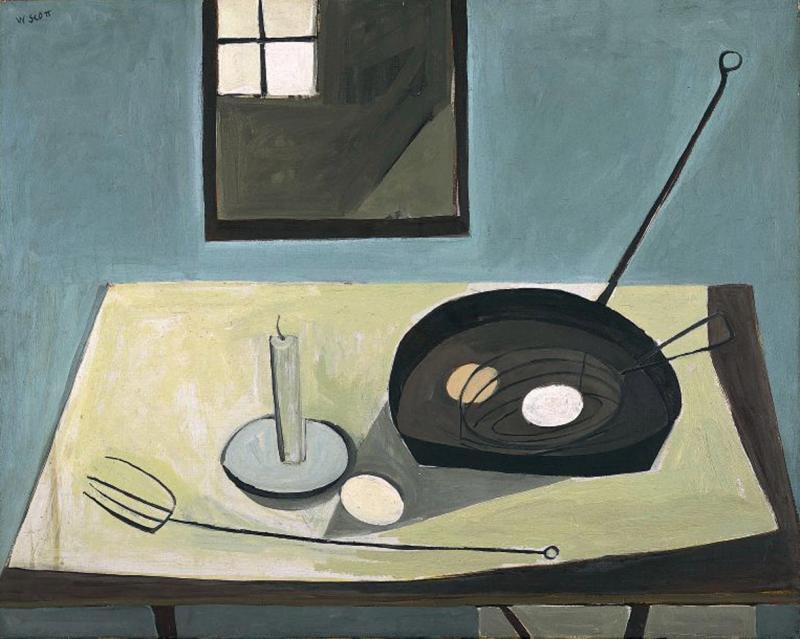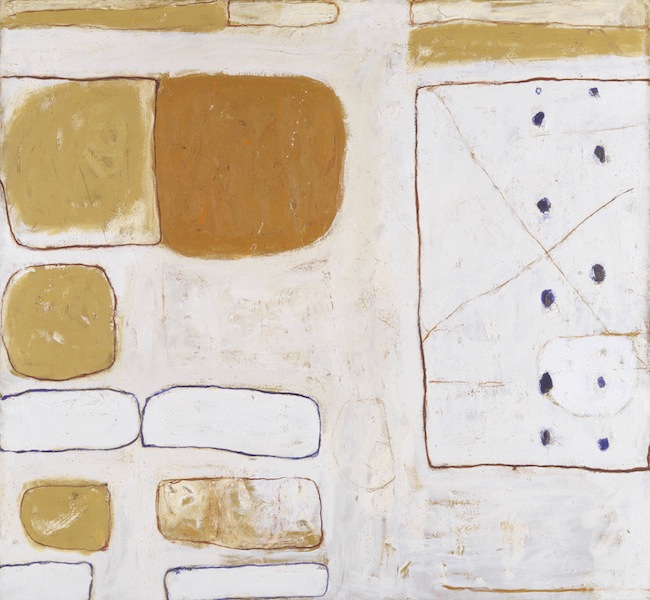William Scott, Hepworth Wakefield | reviews, news & interviews
William Scott, Hepworth Wakefield
William Scott, Hepworth Wakefield
A British modernist whose quiet paintings reward careful observation

It’s the centenary of the birth of William Scott, once considered to be in the pantheon of British postwar artists. But where’s the hoopla and fanfare? Like so many British painters who had their glory years in the Fifties – before the explosion of Pop art and all that – his name no longer carries much weight.
From the two earlier artists he took a distilled sense of domestic space and intense quietude
It’s not just the sexy, cool pop culture of British Pop art that stole the thunder of the British mid-century modernists, but the heroic vigour of American painting in the Fifties. The angsty Kitchen Sink school as well as the colour-infused and fluid semi-abstraction of artists associated with St Ives, as Scott was, came to represent what seemed limited and rather parochial about British painting (and not just painting). And Scott, with his recurring kitchen motifs seemed also to align himself with the former, though we might naturally read the careful placement of pots and eggs and fish and candlesticks as allusive sexual metaphors.
If we compare Scott to Peter Lanyon, another painter of his generation and one to whom he was loosely associated, then we might perhaps begin to further understand why Scott has been rather sidelined, even though he continues to be well-regarded critically and not entirely forgotten. The rather stolid, child-like depiction of forms that Scott so admired in a naïf painter like Alfred Wallis was not to be embraced by succeeding generations writing of the outstanding art of the period. Perhaps it’s been difficult to find an easy slot in which to talk about his work, which is neither fully figurative or literal, nor completely abstract, as if wavering with some indecision between the two.
In fact Scott underwent many transformations during his life, and this exhibition begins with the early and abiding influence of Cézanne, Chardin, and Matisse. From the two earlier artists he took a distilled sense of domestic space and intense quietude, and from the Matisse he learnt to explore heightened colour relations. We explore these early influences in a small selection of paintings, while the main gallery takes us from the late Forties to the Seventies, taking in the influence of Rothko and Pollock, particularly Rothko, with whom he struck up a friendship. This is a dense and rich hang, following no clear chronology but presented with an eye to echoing motifs, often so pared down as to appear completely abstract, although he ultimately resisted this.
 We go from the smooth surfaces and shallow, Cubist spaces of paintings such as Still Life with Candlestick, 1949-50 (main picture), which, with its backdrop of intense blue and blocks of receding space, is certainly one of the more visually seductive paintings in the exhibition, to the later ochres and warm earth tones and flat surfaces of his large-scale canvases inspired by a visit to the Lascaux Caves (pictured right: White, Sand and Ochre, 1960-1; Tate © 2013 estate of William Scott). In Blue Abstract, which won the John Moores prize in 1959, we find him scoring and marking an impastoed surface shimmering with pearly white and icy blue lozenges against a rusty-brown backdrop/table. Meanwhile, in the last room, which mainly shows a selection of drawings, we see a return to the flat, smooth and minimal surface with two paintings from the coolly seductive Berlin Blue series of the mid-Seventies.
We go from the smooth surfaces and shallow, Cubist spaces of paintings such as Still Life with Candlestick, 1949-50 (main picture), which, with its backdrop of intense blue and blocks of receding space, is certainly one of the more visually seductive paintings in the exhibition, to the later ochres and warm earth tones and flat surfaces of his large-scale canvases inspired by a visit to the Lascaux Caves (pictured right: White, Sand and Ochre, 1960-1; Tate © 2013 estate of William Scott). In Blue Abstract, which won the John Moores prize in 1959, we find him scoring and marking an impastoed surface shimmering with pearly white and icy blue lozenges against a rusty-brown backdrop/table. Meanwhile, in the last room, which mainly shows a selection of drawings, we see a return to the flat, smooth and minimal surface with two paintings from the coolly seductive Berlin Blue series of the mid-Seventies.
The retrospective will accrue more paintings as it travels to its last destination in Belfast’s Ulster Museum in October (its first stop was Tate St Ives and the three venues were chosen as locations to which Scott had some association: he worked in Cornwall, he was shown alongside Barbara Hepworth and Francis Bacon in a groundbreaking exhibition on British Modernism in Wakefield, and he grew up in Ulster). Meanwhile his lesser-known nudes can be seen at Jerwood Hastings until July.
He may not possess the heady brilliance and vigour of Lanyon’s landscapes, but Scott’s quiet and intense paintings reward careful observation.
Explore topics
Share this article
more Visual arts
 Yinka Shonibare: Suspended States, Serpentine Gallery review - pure delight
Weighty subject matter treated with the lightest of touch
Yinka Shonibare: Suspended States, Serpentine Gallery review - pure delight
Weighty subject matter treated with the lightest of touch
 Jane Harris: Ellipse, Frac Nouvelle-Aquitaine MÉCA, Bordeaux review - ovals to the fore
Persistence and conviction in the works of the late English painter
Jane Harris: Ellipse, Frac Nouvelle-Aquitaine MÉCA, Bordeaux review - ovals to the fore
Persistence and conviction in the works of the late English painter
 Sargent and Fashion, Tate Britain review - portraiture as a performance
London’s elite posing dressed up to the nines
Sargent and Fashion, Tate Britain review - portraiture as a performance
London’s elite posing dressed up to the nines
 Zineb Sedira: Dreams Have No Titles, Whitechapel Gallery review - a disorientating mix of fact and fiction
An exhibition that begs the question 'What and where is home?'
Zineb Sedira: Dreams Have No Titles, Whitechapel Gallery review - a disorientating mix of fact and fiction
An exhibition that begs the question 'What and where is home?'
 Yoko Ono: Music of the Mind, Tate Modern review - a fitting celebration of the early years
Acknowledgement as a major avant garde artist comes at 90
Yoko Ono: Music of the Mind, Tate Modern review - a fitting celebration of the early years
Acknowledgement as a major avant garde artist comes at 90
 Unravel: The Power and Politics of Textiles in Art, Barbican review - the fabric of dissent
An ambitious exploration of a neglected medium
Unravel: The Power and Politics of Textiles in Art, Barbican review - the fabric of dissent
An ambitious exploration of a neglected medium
 When Forms Come Alive, Hayward Gallery review - how to reduce good art to family fun
Seriously good sculptures presented as little more than playthings or jokes
When Forms Come Alive, Hayward Gallery review - how to reduce good art to family fun
Seriously good sculptures presented as little more than playthings or jokes
 Entangled Pasts 1768-now, Royal Academy review - an institution exploring its racist past
After a long, slow journey from invisibility to agency, black people finally get a look in
Entangled Pasts 1768-now, Royal Academy review - an institution exploring its racist past
After a long, slow journey from invisibility to agency, black people finally get a look in
 Barbara Kruger, Serpentine Gallery review - clever, funny and chilling installations
Exploring the lies, deceptions and hyperbole used to cajole, bully and manipulate us
Barbara Kruger, Serpentine Gallery review - clever, funny and chilling installations
Exploring the lies, deceptions and hyperbole used to cajole, bully and manipulate us
 Richard Dorment: Warhol After Warhol review - beyond criticism
A venerable art critic reflects on the darkest hearts of our aesthetic market
Richard Dorment: Warhol After Warhol review - beyond criticism
A venerable art critic reflects on the darkest hearts of our aesthetic market
 Dineo Seshee Raisibe Bopape: (ka) pheko ye / the dream to come, Kiasma, Helsinki review - psychic archaeology
The South African artist evokes the Finnish landscape in a multisensory installation
Dineo Seshee Raisibe Bopape: (ka) pheko ye / the dream to come, Kiasma, Helsinki review - psychic archaeology
The South African artist evokes the Finnish landscape in a multisensory installation
 Paul Cocksedge: Coalescence, Old Royal Naval College review - all that glitters
An installation explores the origins of a Baroque masterpiece
Paul Cocksedge: Coalescence, Old Royal Naval College review - all that glitters
An installation explores the origins of a Baroque masterpiece

Add comment